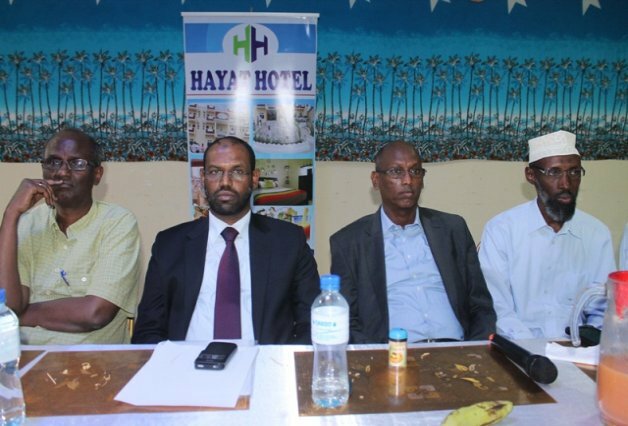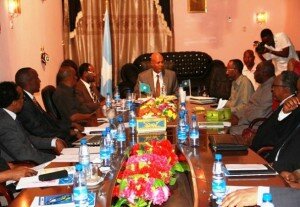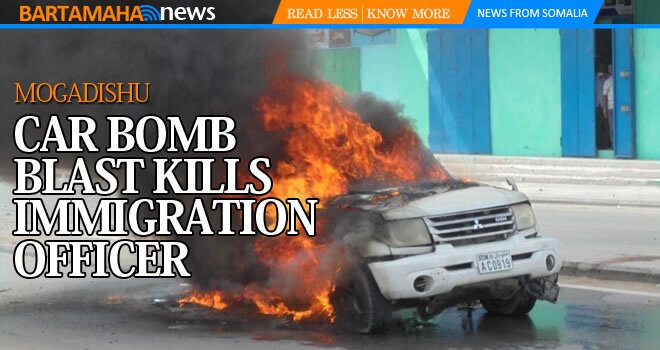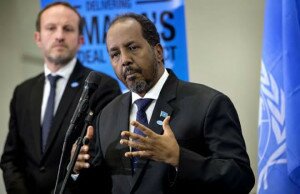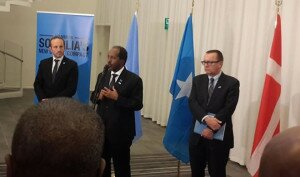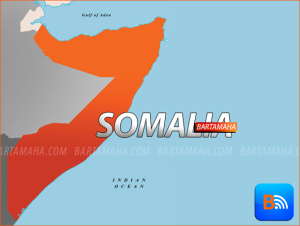Twenty Years of Collapse and Counting
The Cost of Failure in Somalia

Download this report (pdf)
The disastrous famine in Somalia is the worst the world has seen in 20 years, and it again casts a harsh spotlight on the situation in that country. With millions of people now at risk of starvation, and appalling stories of human hardship dominating the evening news, the name “Somalia” once again conjures images of crisis and despair—a famished, suffering country peopled by pirates, terrorists, and warlords.
Somalia is best known for the civil war and famine of the early 1990s, which killed some 250,000 people and triggered a massive, U.S.-led humanitarian intervention that culminated in the infamous “Black Hawk Down” incident of 1994. More recently, the rise of indigenous Islamist movements in southern Somalia has rekindled fears that the anarchic territory could—or has—become a safe haven for Al Qaeda and other transnational terrorist movements.
Western and regional efforts to reduce the terror threat by establishing a central government in Somalia have failed to improve governance. A recent confidential audit of the Somali government suggests that in 2009 and 2010 some 96 percent of direct bilateral assistance to the government had simply disappeared, presumably into the pockets of corrupt officials. The repeated failure of international efforts to produce positive change in Somalia has generated fatigue among donors at a time when Somalia’s needs have never been greater.
 “An ounce of prevention is worth a pound of cure” is rightfully a well-worn adage. Yet in the world of foreign policy it is an exceedingly difficult credo to translate from convenient talking point into practice. As much as policy experts and others, including the U.S. secretary of defense, call for sensible investments in crisis prevention, international development, and expanded diplomatic capabilities, the default setting of the U.S. government and its partners in the international community is to scrimp on crisis prevention while pouring money into crisis response and containment. By and large, the U.S. government ends up spending far more time and money responding to crises or tinkering with tactical responses than preventing crises or nurturing effective peacebuilding efforts. This paper explores the staggeringly high cost of this approach by looking at the case of Somalia.
“An ounce of prevention is worth a pound of cure” is rightfully a well-worn adage. Yet in the world of foreign policy it is an exceedingly difficult credo to translate from convenient talking point into practice. As much as policy experts and others, including the U.S. secretary of defense, call for sensible investments in crisis prevention, international development, and expanded diplomatic capabilities, the default setting of the U.S. government and its partners in the international community is to scrimp on crisis prevention while pouring money into crisis response and containment. By and large, the U.S. government ends up spending far more time and money responding to crises or tinkering with tactical responses than preventing crises or nurturing effective peacebuilding efforts. This paper explores the staggeringly high cost of this approach by looking at the case of Somalia.
This research tries to determine—using a variety of official and unofficial sources and some educated guesswork—a reasonable estimate of the financial cost of Somalia’s conflict since 1991. We tried to be as exhaustive as possible in determining the money spent on Somalia by the international community, regional actors, and the Somali diaspora, regardless of the specific intentions of spending and whether these expenditures were sensible and effective or not. It is our hope that the data explored in this paper can provide the foundation for a useful cost-benefit analysis of what has and has not worked in Somalia. We welcome any additional insights into our methodology and findings.
The profound lack of reliable data and the enormous variance in the economic and political standing of Somalia’s regions complicated our efforts. Statistics from the relative success story of Somaliland are conflated with the catastrophic figures from southern Somalia. (So, for example, the absence of development funding to the south is partially obscured by recent, significant increases in funding to the relatively stable, democratic northern enclave of Somaliland.) Extrapolations based on partial or unreliable data are noted in the text, and unless otherwise indicated all statistics given in this paper reflect data from southern Somalia, Puntland, and Somaliland.
Our research also makes no attempt to calculate the indirect costs or the possible “benefits” of state failure in Somalia. We can assume that Kenya and Ethiopia, among other states, have suffered a reduced gross domestic product as a result of the ongoing disorder in Somalia. But they also may have accrued certain benefits.
For instance, Somalis annually purchase half a billion dollars of khat (a highly addictive narcotic plant native to East Africa) imports from Ethiopia and Kenya, and the Eastleigh neighborhood of Nairobi has seen a tremendous economic boom as a result of Somali diaspora investment. Kenya also has profited from humanitarian traffic through its ports and its status as an international development hub.
These benefits would to some extent offset the costs of state failure in Somalia. Future iterations of the research will attempt to better capture these dynamics.
Despite the shortcomings in available data, however, a useful snapshot of the total funding dedicated to Somalia since 1991 emerges. And it reveals a number of compelling and sometimes surprising trends that should begin to shape policy approaches. Additionally, this accounting makes clear that Western policymakers are wildly uneven in their approach to Somalia. They are willing to spend vast sums in some areas such as dealing with piracy, while in other areas they take an approach bordering on malignant neglect.
Somalia is fairly modest in size, its territory equivalent to an area slightly smaller than Texas. Its population, estimated at just more than 10 million people, is slightly larger than Michigan’s, and its estimated annual gross domestic product is smaller than that of Togo, Guam, or the Faroe Islands. Yet since Somalia became one of the world’s premier examples of a country seemingly in permanent crisis in 1991, the international community has poured enormous resources into this small patch of land, and no end is in sight. Indeed, the humanitarian needs of Somalia’s population are escalating sharply, and the dire situation in that country could again trigger some kind of extraordinarily expensive major international intervention beyond the scope that we have seen to date.
The cost of Somalia’s ruin is nothing short of staggering. There is certainly a heavy human toll: Between 450,000 to 1.5 million Somalis have died due to violence or hunger in the ongoing conflict, and more than 2.3 million Somalis are still refugees or displaced. But the cost of international humanitarian aid, peacekeeping forces, responding to piracy, and myriad other interventions have steadily accumulated year after year.
In what is a conservative estimate the international community, including the Somali diaspora, has collectively spent just over $55 billion responding to Somalia since 1991. These costs have grown far higher and manifested themselves in ways that few would have imagined when the crisis truly began to unravel in 1991 and 1992.
Before turning to the data we need to make several fundamental points.
First and foremost, none of this research is to argue that we should no longer assist Somalia with its pressing humanitarian needs. Indeed, if anything, the data compiled here indicate the need for long-term development, defensive, and diplomatic strategies to mitigate Somalia’s long-running tragedy.
In many ways the pattern of international intervention in Somalia has long remained in the unhappy middle: insufficiently robust or well designed to resolve the country’s conflicts but far too heavy handed and frequent to allow the country to resolve its own problems. Many of the interventions in Somalia were so badly planned and implemented that they made the overall situation far worse in the long run.
Second, this report recognizes that the conditions within Somalia vary widely by region. Somaliland and other parts of the north have achieved a far greater degree of stability and self-governance than the south. These divergent conditions on the ground lead some to question the viability of Somalia’s borders as currently constructed. Somaliland has long sought international recognition as an independent state.
Other key considerations arising from our research include:
Failed states are rare but incredibly expensive and disruptive
“Failed state” is a loaded term, and it’s clear that there are only a handful of countries around the globe in which the government has broadly collapsed. Numerous commentators point out that warnings of potential failed states happen far more often than they actually occur, and many weak states never actually collapse.
Nevertheless, the costs to the world of those states that do fall into ruin are immense and long lasting. Policymakers show a disturbing tendency to view such weak or failed states first and foremost as a threat to national security because they can become a hotbed of terrorist activity—as has often been argued in Somalia and Afghanistan. Yet the figures in this study make clear that the reverberations of a state unraveling are felt well beyond specific security concerns about counterterrorism and can play out in everything from making regional conflicts more likely to rising insurance rates for companies trying to conduct business within the general vicinity of a failed state.
A surprisingly wide number of actors bear these costs
Somalia and its misery were distant from the minds of most Americans or Europeans until the onset of the recent famine. But there would be a far greater cry for effective diplomacy and policy approaches if people understood the wide variety of actors who ultimately bear the brunt of Somalia’s failure. Because the costs of Somalia are diffused across many actors, no one group of actors has “owned” the crisis, and interventions have been piecemeal.
Indeed, as these numbers make clear everyone from the Department of Defense to insurance companies and humanitarian relief organizations to law enforcement officials end up pouring resources into dealing with Somalia that could be used for far more productive and lasting benefit if Somalia could emerge from its failed state status. Sadly, it is equally important to understand the motivations and interests of those actors who benefit from Somalia’s continuing misery and statelessness, including arms traders, smugglers, local warlords, and others.
Somalia needs the right kind of aid
Somalia’s history makes clear that not all international aid is sensible or effective. If we hope to avoid future failed states we need to be much more principled and effective in how we deliver aid.
The U.S. government generously contributed to the Siad Barre regime in Somalia during the 1980s. Barre’s government was widely recognized as horrible when it came to democracy and human rights, but aid was showered upon Barre because he was seen as an important Cold War ally and a bulwark against Soviet expansionism in the region.
Today, the United States, in pursuit of its modern counterterror objectives, provides continuous indirect financial and military support to Somalia’s Transitional Federal Government despite its proven record of corruption, rampant and admitted use of child soldiers, and frequent inability to maintain control of territory. In fact, the TFG’s record of governance is probably worse than Siad Barre’s in many regards.
The Cold War is over, but governments in North America and Europe still deliver aid to governments that remain slow to embrace democracy and reform their institutions. The TFG has consistently pushed for more aid in recent years, but it won’t make much sense to do more in Somalia beyond humanitarian relief unless the world figures out how to approach its interventions more wisely.
Failed states need comprehensive and locally appropriate solutions
Helping a country emerge from its status as a failed state is incredibly laborious and can take years of patient and hard-nosed diplomacy. This also means that the most successful efforts to turn around a situation like Somalia will be built upon effective international coordination, the constructive involvement of the private sector, and a willingness to make hard long-term choices.
This is quite a departure from current practice. Too often the international response to the situation on the ground in failed states is to lunge toward quick “fixes” that fail to and may actually exacerbate the dynamics of conflict. While U.S. counterterrorism efforts have led to the death or capture of a number of high-value targets, the country’s primary extremist group, Al Shabbab, retains a worrying capacity to attract international recruits and to launch terrorist attacks in the region.
U.S. support for the 2006 Ethiopian invasion of Somalia—which generated wide public support for Al Shabbab—remains a particularly egregious example of an ill-advised tactical approach to Somalia that yielded disastrous long-term results.
Before delving into the costs, however, readers unfamiliar with the country’s history may benefit from some background on Somalia’s conflicts, which we turn to in the next section.
John Norris is the Executive Director of the Sustainable Security and Peacebuilding Initiative at the Center for American Progress and Bronwyn Bruton is a fellow at One Earth Future Foundation.
Download this report (pdf)
Download the introduction and summary (pdf)
Read this paper in your web browser (Scribd)
Comments
comments
 Calendar
Calendar





















